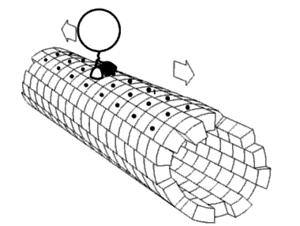Introduction to Nanomotors
- Nanomotors are molecular or nanoscale devices capable of converting energy into movement.
- They can generate forces on the order of piconewtons.
- Scientific research into nanotechnology began after Richard Feynman's famous talk in 1959.
- Feynman's speech inspired a new generation of scientists to pursue research in nanotechnology.
- Nanomotors are the focus of research to overcome microfluidic dynamics and improve current technologies.
Types of Nanomotors
- Nanotube and nanowire motors: First synthetic and autonomous nanomotor fabricated in 2004 by Ayusman Sen and Thomas E. Mallouk.
- Enzymatic nanomotors: Developed using single molecule enzymes and have the potential for biocompatible technologies and medical applications.
- Helical nanomotors: Silica particles coated with magnetic materials that can be maneuvered using a rotating magnetic field.
Applications of Nanomotors
- Nanomedicine: Potential for targeted drug delivery and therapy.
- Biosensing: Nanomotors can be used for sensing and detecting specific molecules.
- Micro/nanorobotics: Nanomotors can be used to manipulate and transport objects at the micro/nanoscale.
Mechanisms of Nanomotors
- Enzyme catalysis: Enzymes drive the motion of nanomotors based on catalytic reactions.
- Chemotaxis: Nanomotors can exhibit directed motion based on chemical gradients.
- Controlled propulsion: Nanomotors can be propelled by various stimuli, such as chemical fuel or ultrasonic power.
Quantum Nanomotors
- Quantum effects in nanomotors: Some nanomotors exhibit quantum behavior due to their small size.
- Applications in quantum computing and information processing: Quantum nanomotors have potential applications in these fields.
Note: The given content can be further organised and grouped based on specific subtopics or themes, but the above grouping provides a comprehensive overview of the main concepts and ideas related to nanomotors.
A nanomotor is a molecular or nanoscale device capable of converting energy into movement. It can typically generate forces on the order of piconewtons.

While nanoparticles have been utilised by artists for centuries, such as in the famous Lycurgus cup, scientific research into nanotechnology did not come about until recently. In 1959, Richard Feynman gave a famous talk entitled "There's Plenty of Room at the Bottom" at the American Physical Society's conference hosted at Caltech. He went on to wage a scientific bet that no one person could design a motor smaller than 400 µm on any side. The purpose of the bet (as with most scientific bets) was to inspire scientists to develop new technologies, and anyone who could develop a nanomotor could claim the $1,000 USD prize. However, his purpose was thwarted by William McLellan, who fabricated a nanomotor without developing new methods. Nonetheless, Richard Feynman's speech inspired a new generation of scientists to pursue research into nanotechnology.

Nanomotors are the focus of research for their ability to overcome microfluidic dynamics present at low Reynold's numbers. Scallop Theory explains that nanomotors must break symmetry to produce motion at low Reynold's numbers. In addition, Brownian motion must be considered because particle-solvent interaction can dramatically impact the ability of a nanomotor to traverse through a liquid. This can pose a significant problem when designing new nanomotors. Current nanomotor research seeks to overcome these problems, and by doing so, can improve current microfluidic devices or give rise to new technologies.[citation needed]
Significant research has been done to overcome microfluidic dynamics at low Reynolds numbers. Now, the more pressing challenge is to overcome issues such as biocompatibility, control on directionality and availability of fuel before nanomotors can be used for theranostic applications within the body.